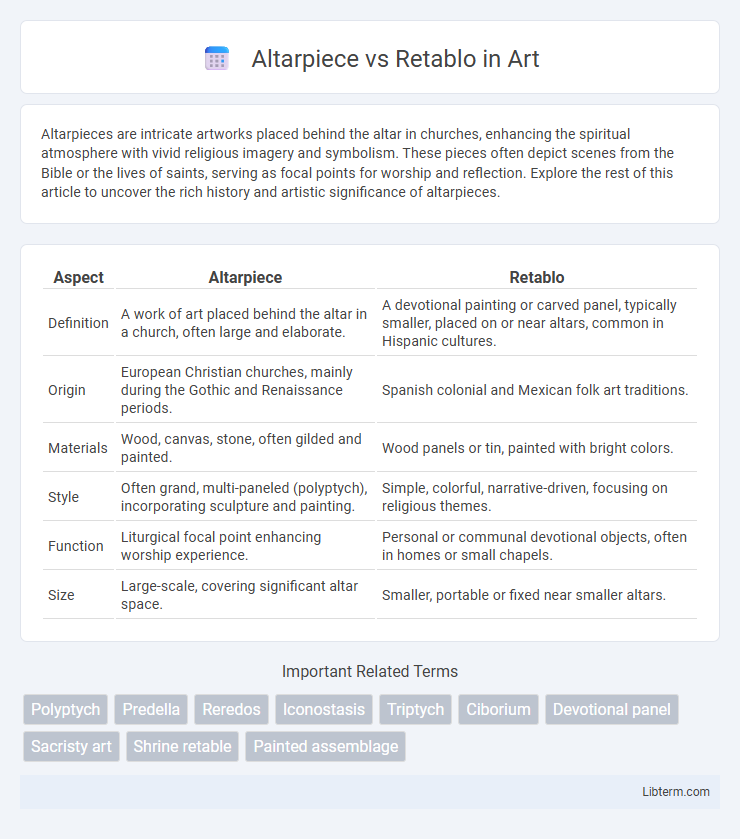Altarpieces are intricate artworks placed behind the altar in churches, enhancing the spiritual atmosphere with vivid religious imagery and symbolism. These pieces often depict scenes from the Bible or the lives of saints, serving as focal points for worship and reflection. Explore the rest of this article to uncover the rich history and artistic significance of altarpieces.
Table of Comparison
| Aspect | Altarpiece | Retablo |
|---|---|---|
| Definition | A work of art placed behind the altar in a church, often large and elaborate. | A devotional painting or carved panel, typically smaller, placed on or near altars, common in Hispanic cultures. |
| Origin | European Christian churches, mainly during the Gothic and Renaissance periods. | Spanish colonial and Mexican folk art traditions. |
| Materials | Wood, canvas, stone, often gilded and painted. | Wood panels or tin, painted with bright colors. |
| Style | Often grand, multi-paneled (polyptych), incorporating sculpture and painting. | Simple, colorful, narrative-driven, focusing on religious themes. |
| Function | Liturgical focal point enhancing worship experience. | Personal or communal devotional objects, often in homes or small chapels. |
| Size | Large-scale, covering significant altar space. | Smaller, portable or fixed near smaller altars. |
Introduction to Altarpiece and Retablo
An altarpiece is a decorated panel or series of panels placed behind an altar, often featuring religious paintings or sculptures that depict biblical scenes or saints, serving as a focal point in Christian worship. Retablos, common in Spanish and Latin American art, are devotional paintings typically on wood or tin, illustrating religious icons, saints, or milagros, and used as portable or fixed objects of veneration. Both altarpieces and retablos function as visual aids in spiritual practices, but altarpieces are usually larger, integrated architectural works, while retablos are smaller, personal devotional tools.
Historical Origins of Altarpiece
The altarpiece originated in the early Christian period, evolving from simple decorated panels to elaborate paintings or sculptures placed behind the altar to enhance liturgical focus. Its development peaked during the Gothic and Renaissance eras, with artists like Rogier van der Weyden and Jan van Eyck creating highly detailed, multi-paneled works. Altarpieces served both theological and artistic purposes, reflecting religious narratives and local devotional practices in European cathedrals and churches.
Historical Evolution of Retablo
Retablos originated in medieval Spain as painted or sculpted panels placed behind altars, evolving from simple devotional images to complex multi-paneled narrative artworks during the Gothic and Renaissance periods. Their historical evolution reflects the fusion of religious, cultural, and artistic influences, transitioning from European church settings to Latin American colonial contexts, where indigenous techniques and motifs enriched the tradition. This transformation highlights retablos as dynamic expressions of faith and identity, distinct from the more static, often singular altarpieces focused primarily on Christological themes.
Key Artistic Differences
Altarpieces typically feature a multi-panel structure often incorporating painted or sculpted scenes arranged vertically or horizontally, emphasizing narrative complexity and visual hierarchy. Retablos are usually smaller, devotional images painted on wood or metal, characterized by folk art styles with vibrant colors and simplified forms focused on religious iconography. The key artistic difference lies in altarpieces' grand, architectural integration with church interiors compared to retablos' intimate, portable nature serving personal or household worship.
Materials and Techniques Used
Altarpieces traditionally consist of painted panels, carved wood, or gilded metal, often featuring tempera or oil paints applied on wooden panels with intricate detailing and layering techniques. Retablos, commonly found in Latin American folk art, utilize simpler materials such as tin, wood, and oil paint, emphasizing handcrafted, vibrant imagery with a folk aesthetic and devotional themes. Both art forms employ diverse techniques reflective of their cultural origins, with altarpieces exhibiting formal, ecclesiastical artistry and retablos showcasing accessible, community-driven craftsmanship.
Religious and Cultural Significance
Altarpieces and retablos serve as vital visual elements in Christian worship, symbolizing divine presence and religious narratives. Altarpieces, often large and elaborate, are central in Catholic churches, depicting saints, Biblical scenes, and Christ's life, enhancing spiritual reflection during Mass. Retablos, particularly prominent in Spanish and Latin American traditions, typically feature painted or carved panels focused on localized devotion, blending indigenous artistry with Christian iconography to preserve cultural identity and religious heritage.
Iconography in Altarpiece vs Retablo
Altarpieces often feature intricate iconography centered on biblical scenes and saints, serving as visual theology in churches, while retablos emphasize folk religious imagery and devotional subjects reflecting local cultural traditions. Altarpieces typically incorporate sculptural elements and painted panels arranged hierarchically to convey spiritual narratives. Retablos are usually smaller, portable, and characterized by vivid, naive iconography meant for personal or communal worship outside formal church settings.
Geographic Prevalence and Styles
Altarpieces, common in Northern European churches, often feature elaborate, multi-paneled paintings or sculptures with Gothic or Renaissance styles emphasizing detailed narrative scenes. Retablos, prevalent in Latin American and Spanish colonial regions, typically display brightly colored, folk-art influenced images on wooden panels or metal plaques, reflecting indigenous and Catholic syncretism. Geographic prevalence shapes their stylistic expressions and cultural symbolism within Christian liturgical art.
Famous Examples Around the World
The Ghent Altarpiece by Jan van Eyck, housed in St. Bavo's Cathedral, Belgium, exemplifies the intricate detail and religious significance of altarpieces in Western art. In contrast, the Retablo of San Miguel de Allende in Mexico showcases vibrant folk art traditions and Catholic iconography central to Mexican culture. Both serve as pivotal examples of sacred art, highlighting regional styles and devotional purposes worldwide.
Contemporary Interpretations
Contemporary interpretations of altarpieces often incorporate modern materials and abstract designs, reflecting current artistic trends while maintaining their devotional function. Retablos in contemporary contexts blend traditional iconography with personal narratives and political themes, expanding beyond their original religious purposes. Both forms continue to evolve, serving as dynamic mediums that bridge historical art and modern expression in sacred and secular spaces.
Altarpiece Infographic

 libterm.com
libterm.com